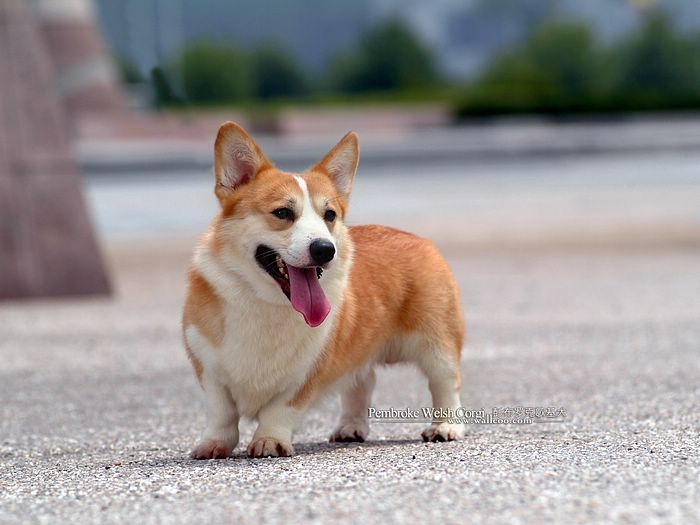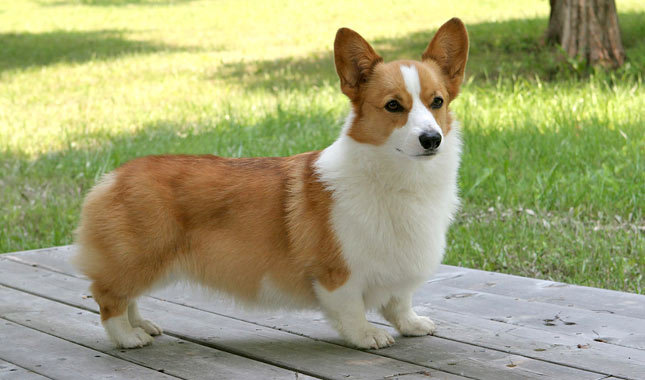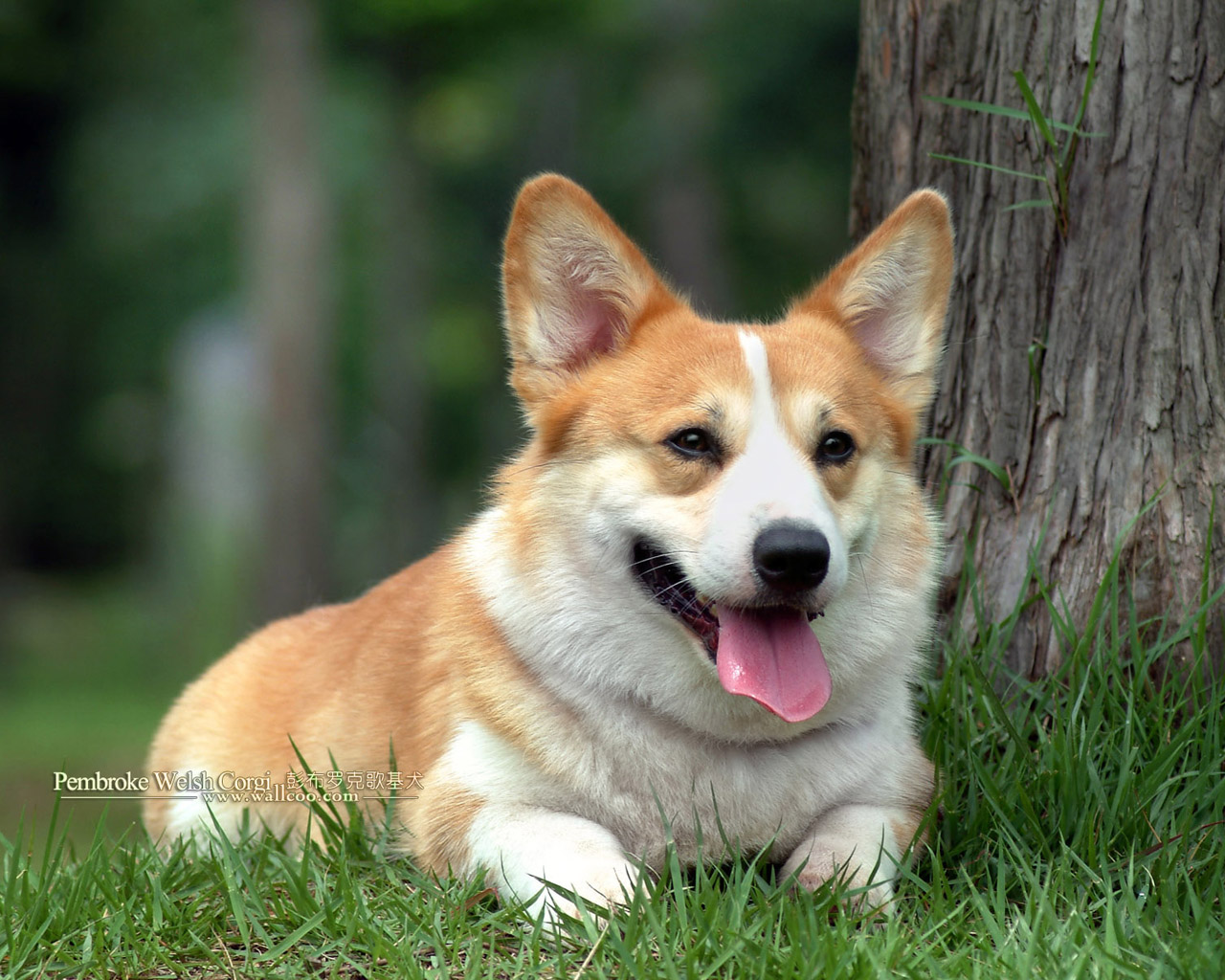
The Breed History
Though often considered an offshoot of the Cardigan Welsh Corgi
family, the Pembroke Corgis may trace further back, to about the
year 1107. Various breeds are thought to have contributed to the
corgi type including Shipperke, Finnish Spitz, Keeshond, Swedish
Vallhunds, and Samoyed. Cross breeding with Cardigans occurred,
and only in the last 75 years have the registries bred separately.
The Pembroke lines matured in Pembrokeshire, Wales. Corgi is
thought to mean dog in Celtic, or in Welsh, dwarf dog. This breed
was brought to the public's attention as the chosen pets of Queen
Elizabeth. AKC first recognized Pembrokes in 1934.
Breeding for Function
Bred originally as cattle driving dogs, they are also excellent
watchdogs, and are successful at obedience trials. Their talents
also include tracking and agility. They are valued for their loyal
companionship.
Physical Characteristics
Height at Withers: female 10-12" (25.4-30.5 cm), male 10-12"
(25.4-30.5 cm)
Weight: females under 28 lb (12.5 kg), males under 30 lb (13.5 kg).
Coat: A short to medium length, it is composed of an undercoat
and coarser outer coat. The dog is shown basically untrimmed.
White is acceptable in markings of chest, leg, neck and small
amounts only on face. Body colors are black and tan, red, fawn, and
sable. Predominantly white coats, or coats with a bluish/smoky cast
are serious faults. Some dogs are tri-colored.
Longevity: 12-15 years.
Points of Conformation: The Pembroke is finer boned and smaller
than the Cardigan, but still gives the impression of strength.
Pembrokes have pointed erect ears and are short-tailed, while the
Cardigan's ears are less pointed and they have a long tail. A low-set
dog, Pembrokes are well known for their agility and stamina. They
are longer than high, topline is level, neck is long, and the head
is large with moderate stop and fox-like proportions with a keen
expression. The eyes are oval, oblique and brown, and the nose is
black. Ribs are deep and well sprung. Tails are usually docked short,
though puppies are sometimes born with naturally short tails.
Forelegs are bowed due to the chondrodystrophic type of the breed.
Feet are well arched, and the dewclaws are generally removed all
around. They move with a long low stride.
Recognized Behavior Issues and Traits
This is considered an ideal small housedog because of their friendly
intelligence. They are also reported to be loud vigilant alarm barkers.
Breed standards are firm that the dog should not be shy or vicious.
They may try to herd their humans by nipping at heels, but can be
trained away from this behavior. They are devoted, and are a bit
more active on average than the Cardigan Corgis, though perhaps
gentler on average. The coat just needs routine grooming and they
are considered moderate shedders. At the very least, a few brisk
walks daily are needed, and they should only be turned out into
fenced enclosures. Obedience training is strongly recommended,
along with early training and socialization. They need close human
contact, and if left alone for long periods, they may chew or bark.
Normal Physiologic Variations
Weight (kg): 15 (8-19)
Heart rate (bpm): 120 (80-160)
LVPWD (mm): 8 (6-10)
LVPWS (mm): 12 (8-13)
LVD (mm) 32: (28-40)
LVS (mm) 19: (12-23)
FS (%) 44: (33-57)
EPSS (mm): 2 (0-5)
RVd (mm) 10: (6-14)
IVSd (mm) 8: (6-9)
IVSs (mm) 12: (10-14)
AOD (mm) 18: (15-22)
LAS (mm) 21: (12-24)
N 20
LVPWD, LV posterior wall dimension at end-diastole; LVPWS, LV
posterior wall thickness at end-systole; LVD, LV chamber dimension
at end-diastole; LVS, LV chamber dimension at end-systole; FS,
percent fractional shortening; EPSS, E-point septal separation; RVD,
RV chamber dimension at end-diastole; IVSd, interventricular septal
thickness at end-diastole; IVSs, interventricular septal thickness at
end-systole; AOD, aortic root at end-diastole; LAS, left atrium at
end-systole; N, number of animals.
Natural Bob-Tail: Pembroke Welsh Corgis exist due to the
heterozygous dominant expression of the T gene. Most genetic
studies find that homozygous dominant individuals are pre-natally
lethal. However, one study found that homozygous dominant
Pembroke Welsh Corgis were born tailless, with anorectal atresia
and multiple spinal defects. Due to this finding, natural bob-tail Pembroke Welsh Corgis should not be bred together, and should
only be bred to normal-tailed dogs. This will produce 50% bob-tail
and 50% normal-tail offspring.
Fluffy Coat Length: An autosomal recessive condition causing a
long, fluffy coat exists in the Pembroke Welsh Corgi. Dogs with this
coat type are not eligible for competition. A genetic test is available.
In a UK study, 35.7% of litters were born via Cesarean section.
Drug Sensitivities
None reported
Inherited Diseases
Hip Dysplasia: Polygenically inherited trait causing degenerative
joint disease and hip arthritis. OFA reports 18.4% affected.
von Willebrand's Disease Type 1 (vWD): Autosomal recessive
genetic disorder causing a mild bleeding syndrome. A direct genetic
test is available from VetGen, reporting 6% affected, and 37%
carrier in the breed.
Elbow Dysplasia: Polygenically inherited trait causing elbow
arthritis. OFA reports 3.0% affected.
Patella Luxation: Polygenically inherited laxity of patellar ligaments,
causing luxation, lameness, and later degenerative joint disease. Treat
surgically if causing clinical signs. Too few Pembroke Welsh Corgis
have been screened by OFA to determine an accurate frequency.
Disease Predispositions
Persistent Pupillary Membranes: Strands of fetal remnant
connecting; iris to iris, cornea, lens, or involving sheets of tissue. The
later three forms can impair vision, and dogs affected with these
forms should not be bred. Identified in 19.19% of Pembroke Welsh
Corgis CERF examined by veterinary ophthalmologists between
2000-2005. Dorn reports a 9.01x increased odds ratio versus other
breeds.
Retinal Dysplasia: Retinal folds, geographic, and generalized retinal
dysplasia with detachment are recognized in the breed. Reported
in 4.92% of Pembroke Welsh Corgis CERF examined by veterinary
ophthalmologists between 2000-2005. Suspected autosomal
recessive inheritance. CERF does not recommend breeding any
Pembroke Welsh Corgi with retinal dysplasia.
Cataracts: Anterior, posterior, and nuclear cortex intermediate
cataracts predominate in the breed. Identified in 3.15% of Pembroke
Welsh Corgis CERF examined by veterinary ophthalmologists
between 2000-2005. CERF does not recommend breeding any
Pembroke Welsh Corgi with a cataract.
Hypothyroidism: Inherited autoimmune thyroiditis. 2.1% positive
for thyroid auto-antibodies based on testing at Michigan State
University. (Ave. for all breeds is 7.5%).
Distichiasis: Abnormally placed eyelashes that irritate the cornea
and conjunctiva. Can cause secondary corneal ulceration. Identified
in 1.49% of Pembroke Welsh Corgis CERF examined by veterinary
ophthalmologists between 2000-2005.
Intervertebral Disc Disease (IVDD): Serious neurological condition
where disk degeneration and rupture into spinal nerves and the
spinal cord causes pain and possible paralysis. Requires immediate
veterinary attention. Occurs at an increased frequency in the breed.
Degenerative Myelopathy (DM): Affected dogs show an insidious
onset of upper motor neuron (UMN) paraparesis at an average
age of 11.4 years. The disease eventually progresses to severe
tetraparesis. Affected dogs have normal results on myelography,
MRI, and CSF analysis. Necropsy confirms the condition. Reported
at a frequency of 0.58% in Pembroke Welsh Corgis. Unknown mode
of inheritance. A direct genetic test for an autosomal recessive DM
susceptibility gene is available. All affected dogs are homozygous
for the gene, however, only a small percentage of homozygous dogs
develop DM. OFA testing shows 39% carrier and 52% homozygous
"at risk" for the DM susceptability gene.
Bladder Stones: The breed has a predisposition to develop bladder
stones. Stone composition is not identified. Dorn reports a 4.20x
increased odds ratio versus other breeds.
Cystinuria/Cystine Bladder Stones: Caused by a metabolic
abnormality in cystine metabolism. Welsh Corgis have an
increased risk for developing cystine bladder stones. Treat with
surgical removal and life-long medical therapy. Unknown mode of
inheritance in this breed.
Perineal Hernia: An Australian study identified the Corgi breed as
most commonly affected with perineal hernias. The mean age of
affected dogs was 9.4 years. Treatment is herniorrhaphy surgery.
Patent Ductus Arteriosus (PDA): Polygenically inherited
congenital heart disorder, where a fetal vessel remains open
after birth, causing a mixing of oxygenated and unoxygenated
blood. Affected dogs are usually stunted, and have a loud heart
murmur. Diagnosis with Doppler ultrasound. Treat with surgery.
Some Pembroke Welsh Corgis have been reported with concurrent
pulmonary hypertension or plexogenic pulmonary arteriopathy.
Steroid Responsive Meningitis/Arteritis: Affected dogs present
with apathy, fever, delayed proprioception, ataxia, and/or increased
head and cervical pain. Histopathology shows necrotizing vasculitis
in the CNS, with perivascular granulomatous inflammation. Treat
with steroids. Unknown mode of inheritance.
Brachygnathism, Corneal Dystrophy, Cryptorchidism, Cutaneous
Asthenia, Dermatomyositis, Epilepsy, Methemoglobin Reductase
Deficiency, Narcolepsy, Prognathism, and Progressive Retinal
Atrophy are reported.
Isolated Case Studies
Telangiectasia: Multiple vascular lesions involving kidneys and
various other organs consisting of cavernous, blood-filled spaces
lined by endothelial cells with various amounts of mural collagen.
Described in eight Pembroke Welsh Corgi dogs. The most common
clinical sign associated with this condition is hematuria.
Juvenile Nephropathy: Two related Pembroke Welsh corgi puppies
presented at three and five months of age, respectively, for lethargy,
diarrhoea, poor body condition, polyuria and proteinuria. Based upon the clinical presentation, urinalysis and serum biochemistry,
chronic renal failure was diagnosed. Renal histopathology was
consistent with juvenile nephropathy.
Tongue Atrophy due to Polymyositis: A three-year-old female
Pembroke Welsh Corgi exhibited symptomatic tongue atrophy,
dysphagia and excessive salivation following a bout of masticatory
polymyositis. The dog died of aspiration pneumonia 2 years later.
Genetic Tests
Tests of Genotype: Direct tests for vWD and coat colors are
available from VetGen.
Direct test for an autosomal recessive DM susceptibility gene is
available from the OFA.
Direct test for the fluffy coat gene is available from the Animal
Health Trust, DDC Veterinary and VetGen.
Tests of Phenotype: CHIC Certification: Required testing includes
hip radiographs, and CERF eye examination. Recommended testing includes patella examination, elbow
radiographs, thyroid profile including autoantibodies, genetic test
for vWD, and cardiac examination.
Miscellaneous
- Breed name synonyms: Pembroke, Corgi
- Registries: AKC, CKC, UKC, KCGB (Kennel Club of Great Britain),
ANKC (Australian National Kennel Club), NKC (National Kennel Club)
- AKC rank (year 2008): 24 (8,102 dogs registered)
- Internet resources: Pembroke Welsh Corgi Club of America:
www.pembrokecorgi.org
Pembroke Welsh Corgi Association (Canada):
www.pembrokewelshcorgis.ca
The Welsh Corgi League (UK):
www.pembrokewelshcorgileague.co.uk
Photo Gallery of Breed - Pembroke Welsh Corgi - Dog Breed








 Animalia Life
Animalia Life